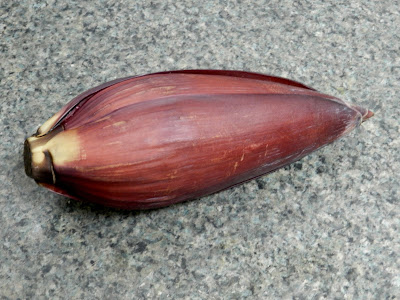 After boning up on our banana flower prep skills on YouTube—who says the Internet is not a great thing?—we peeled this flower down to expose the flowers/immature bananas at the base of each petal.
After boning up on our banana flower prep skills on YouTube—who says the Internet is not a great thing?—we peeled this flower down to expose the flowers/immature bananas at the base of each petal.



And then we kept on peeling until we got to the tender heart that we split with a knife. After removing the fibrous core, we put a fine chiffonade on the banana flower and put the bits in acidulated water to keep them from oxidizing.
The taste of the raw flower was of bitter banana rind. We were hoping that blanching would help eliminate the bitterness. Not so. This dish of Banana Flower and Shrimp Curry looks great, but none of us could get beyond the bitterness of the banana flower.

Vote: Two thumbs down. We'd eat it if another chef brought it to our table as a special treat, but we won't be ordering any for ourselves. Major let down.


Ed, I grew up on an island where eating "babafigue", the banana flower is not unusual. It's often prepared with smoked pork belly or other fatty smoked sausage as well as with shrimp. I have never prepared it myself, but this is what I remember:
ReplyDelete- only eat the pale part
- droop it in acidied water as soon as cut to avoid oxydation
- the blanching starts with cold water, and it's more than we generally understand blanching to be - more like 10 minutes of boiling. But you must start with cold water
- sometime you have to do the prior step a few times, some "babas" are more bitter than others depending on the cultivar and where and how it's been grown
- when it's good, it's really good!
Sylvie,
ReplyDeleteThanks for the tips. We followed all this, except that we only blanched it in the customary Western sense. Next time....
J'ai jamais rencontre "baba-figue", seulement fleur de bananier. La langue creole que l'on parle a la Reunion me semble tres jolie.
You are welcome!
ReplyDeleteVous etes vraiment tres cultive! Si vous etes curieux, j'ai ecrit un poste sur la cuisine reunionnaise et un peu sur le language:
http://www.laughingduckgardens.com/ldblog.php/2010/08/12/on-roots/
In Reunionaise creole, baba is baby and figue is banana (likely via the Portuguse "figo d’orta”), hence baba-figue = baby banana.
Bon poste, merci! Quand j'etais aux marches de St Martin (aux Caraïbes) j'entendais "figue" partout, mais je ne voyais jamais de figues! Il n'y avait que de bananes! Et je connais "baba" seulement dans le sens de grandmere or grandpere.
ReplyDelete